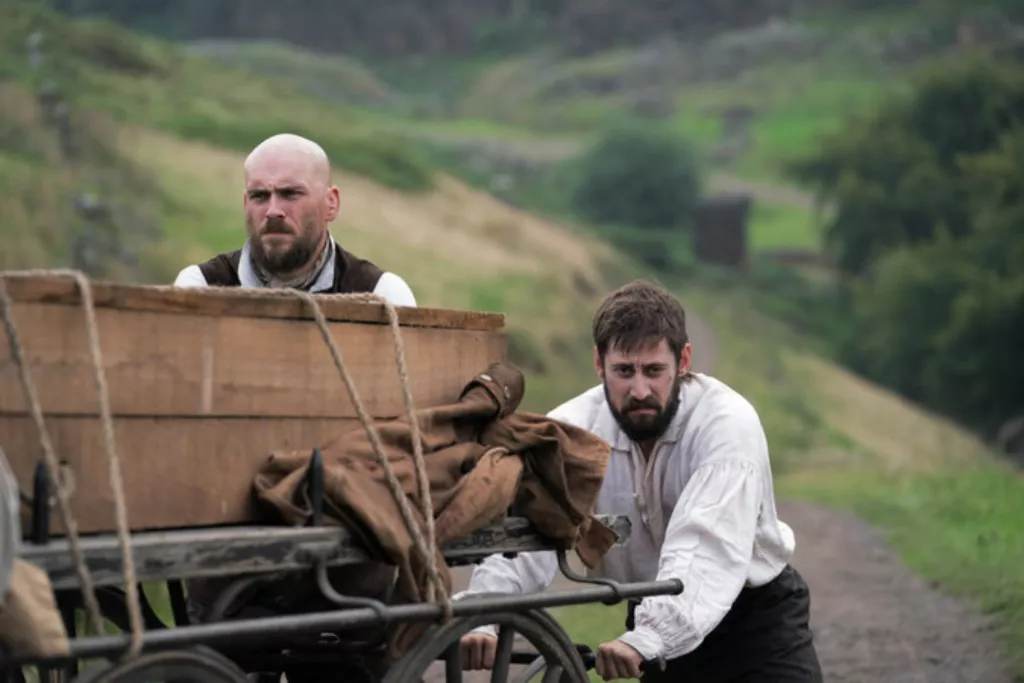In the latest BBC series, The Gallows Pole, viewers will be taken on a thrilling journey through the criminal underworld of West Yorkshire during the industrial revolution. This three-part drama follows the story of how a coining gang forms, becomes involved in the community, and ultimately introduces counterfeit money that threatens to destabilize Georgia’s cash system. After seven years away, David returns to his hometown with a leather satchel and a stab wound. He has just slain a guy. His loved ones and old friends, who are now burdened by industrialization, see him with distrust and disdain.
As a last resort, David organizes a conference to present the counterfeiting idea. The play examines the interplay between desperation, class conflict, and the corrupting influence of money. It goes into the difficulties experienced by the protagonists and provides an engaging story that is at once humorous, touching, angry, and shocking.
The show will focus on a group of impoverished criminals as they navigate their way through a dangerous and unpredictable world. Starring in the series are Michael Socha, Samuel Edward-Cook, Nicole Barber-Lane, Jordan Preston, Ralph Ineson, and Thomas Turgoose. The picturesque Calder Valley and charming Hebden Bridge in Yorkshire serve as stunning locations. The roughcast style, genuine acting, and incorporation of humor and earthy intelligence in “The Gallows Pole” have all garnered high praise. It features a high-caliber drama that will keep you enthralled and thinking about it long after you’ve finished watching. It’s hard not to wonder if ‘The Gallows Pole’ is based on real events, what with all the historical figures. So, (tvacute.com) here’s the lowdown on where that exciting and fascinating tale of “The Gallows Pole” came from.
Is [BBC] The Gallows Pole based on a true story or a book?
A historical drama, “The Gallows Pole” is adapted from Benjamin Myers‘ 2017 book of the same name. The novel follows the true events of an 18th-century gang in Cragg Vale, West Yorkshire. In a stunning adaptation, Director Shane Meadows has brought the captivating tale of David Hartley‘s ascent and his crew to the small screen. David Hartley, also known as “King,” dealt with counterfeiting and violence. The fall of the cottage textiles industry and the emergence of nearby Halifax as a center of trade during the industrial revolution had a devastating effect on the local economy. With his signature touch, Meadows has added some unexpected turns to the already gripping story.
The novel is described as forceful, but also bleak and humorless, with a heavy emphasis on the male characters. Directing “This is England,” however, is a whole new experience because of Shane Meadows‘s distinctive vision. By integrating humor and female characters, Meadows provides contrast and depth to the plot. He keeps the mysterious “stag men” around, but gives the major characters some compassion.
Who is David Hartley and the Cragg Vale Coiners?
In the middle of the 18th century, the industrial revolution was threatening the livelihoods of weavers in the Calder Valley. People were going hungry because the traditional industry was failing in the face of rising mechanization. Professionals felt helpless as they watched their careers wither away, so many turned to dishonest means of regaining independence.
David Hartley led the Cragg Vale Coiners, a gang of Yorkshire forgers who made fake coins worth an estimated £3.5 million (more than £650 million in today’s money). David Hartley, assisted by his brothers and a crew of locals, “clipped” the rims off the real coins, filed them down, then melted them down, reshaped them, stamped them with a fake die, and released them into circulation. Bell House, a farmstead and barn perched on the valley’s edge owned by the Hartleys, served as the mint’s headquarters.
David Hartley of Cragg Vale led the Coiners, who stole government-issued coins from anyone dishonest enough to provide them. They would round off the coins and recast them using a mixture of cheap metals and ores. In the event of a coin scarcity at the Royal Mint, the original coins would be filed to hide any signs of clipping, and counterfeits would be struck to seem like Spanish, French, or Portuguese currency.
The clipped coins and the counterfeits would be smuggled into circulation by the gang members. Because of the business’s success, the gang expanded, and at its height, its 80 members deposited over £3.5 million worth of counterfeit coins into the Bank of England. Hartley and the others had escaped poverty and were enjoying the wealth that had been common among the families of workers in fading industries.
As a direct result of the Coiners’ acts, the value of the pound dropped by 9 percent. In 1769, public official William Dighton launched an official investigation after rumors spread that a gang from Yorkshire would be responsible. James Broadbent, a member of the gang, ratted out his fellow Coiners to Dighton, leading to the arrest of David Hartley.
Isaac, Hartley’s brother, had Dighton killed because of his interference. Dighton was attacked and killed in Bull Close Lane in Halifax by two farm laborers employed by the Coiners, Matthew Normanton, and Robert Thomas. Later, Robert Thomas was hung for robbing Deighton on the highway. Officials eventually tracked down the Coiners as a possible suspect group and detained 30 of them on Christmas Day, 1769. Hartley was found guilty and executed alone; his burial is in Heptonstall and the date was April 28, 1770.
Is Starz’s Dangerous Liaisons Based on a True Story?
